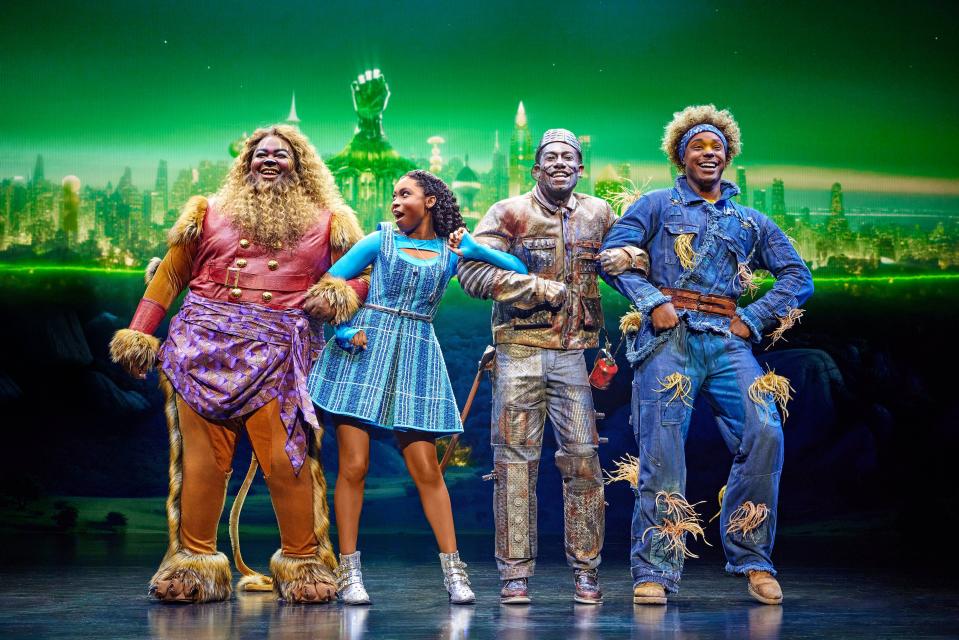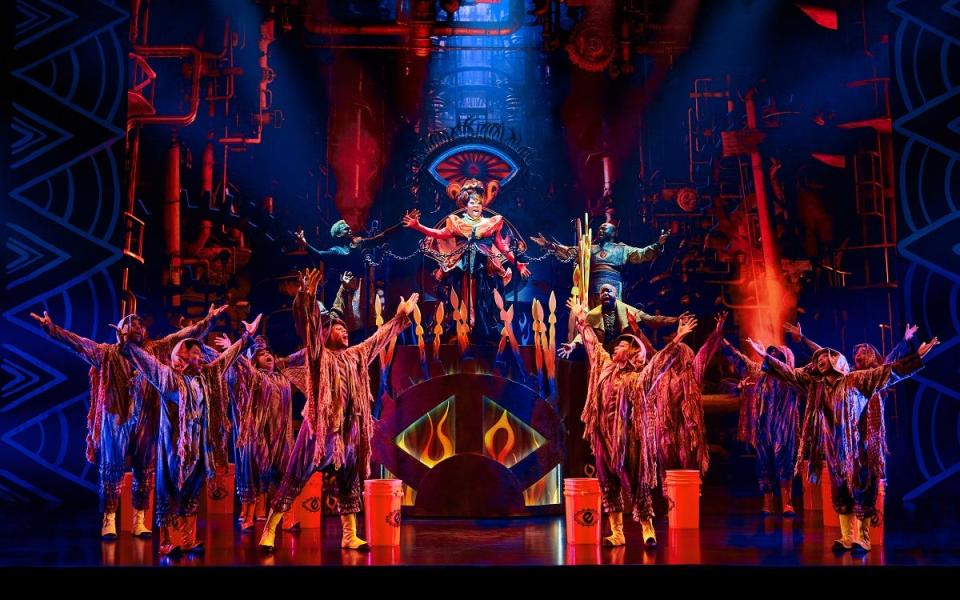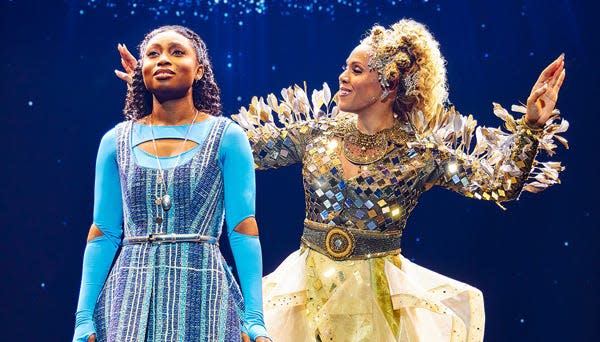Fifty years later, 'The Wiz' is returning to Broadway for a victory lap
Magic, as we learn in "The Wizard of Oz," can be found in the least likely places. A bucket of water. A pair of slippers.
Or, in the case of "The Wiz," the 1975 Broadway musical, a 30-second TV spot.
"Come on and ease on down, ease on down the road!" sang Stephanie Mills and her pals in the commercial, which was seen all over the New York market in the spring of 1975. "The Wiz is a wow!" declared the announcer.
It was key to transforming "The Wiz" from a borderline failure, with mixed-to-negative reviews and a short life expectancy, to a Tony-winning phenomenon that spawned tours, TV specials, a 1978 film, and — this year — the first true Broadway revival, opening at the Marquis Theatre on April 17 (previews begin March 29) after an extensive cross-country tour.

"The show was thought to be kind of dead on arrival before it had even arrived," said Caseen Gaines, the Hackensack author who unpacks the entire "Wiz" saga in a forthcoming book, "If Ever a Wiz There Was," due out next year.
Fleshing it out
The new production, starring Nichelle Lewis as Dorothy, Avery Wilson as the Scarecrow, Phillip Johnson Richardson as the Tinman, and Kyle Ramar Freeman as the Lion, has a book revised by Amber Ruffin ("Some Like It Hot") that updates the original by William F. Brown and provides some more backstory for Dorothy. Also — perhaps inevitably, given the success of Broadway's "Wicked" — for Evillene, the Wicked Witch of the West, played by Melody A. Betts, who doubles as Aunt Em.

"She's such a powerhouse of a performer," said Gaines, author of "When Broadway Was Black" and "Inside Pee-Wee's Playhouse," who saw the revival several times out of town.
"I saw it three times in Baltimore, and every time she sang 'No Bad News,' the audience jumped out of their seats," Gaines said. "It was like church in the theater. That performance by itself is worth the price of admission."

What it retains, of course, is the Charlie Smalls score, with all the familiar songs such as "Believe in Yourself," "The Feeling We Once Had" and, of course, "Ease on Down the Road" — all Broadway boilerplate these days, but a shocking travesty to some back in 1975, who couldn't cope with a funky Black retelling of their beloved "Wizard of Oz."
The critics weigh in
"There were some overtly racist reviews," Gaines said. Not, he says, unlike some of the recent commentary over the casting of Halle Bailey as Ariel in "The Little Mermaid" or Hackensack's Rachel Zegler as a Latina Snow White in the upcoming live-action remake.
"Garbage is garbage no matter what color it is," Rex Reed wrote in the Daily News in 1975.
Reed took issue with the lion's Afro and a Wizard of Oz who looked like "a Times Square pimp," and suggested that Judy Garland fans picket the show.
"Just because something is Black does not make it automatically beautiful," he wrote.
More unexpectedly, E.Y. Harburg, lyricist of "Over the Rainbow" and the other "Wizard of Oz" songs — a lifelong progressive, who wrote the anti-racist musical "Finian's Rainbow" — was also horrified. "They had taken the beautiful imagination children have at a certain age — the one age when they have idealism — and thrown rotten eggs and mud at it," he said.
"I think there's something sadly predictable about the response," Gaines said. "For some people I think it's an honest reaction rooted in nostalgia — for the entertainment they grew up with remaining the way they remember it."
True to the source
Ironically, "The Wiz" was in some ways truer to the 1900 L. Frank Baum book than the famous 1939 film version was — down to such features as the half-bear, half-tiger Kalidahs, shoes that are silver rather than ruby, and tinted glasses that made the Emerald City look green (one of the Wizard's more egregious scams).
But if some in the "mainstream" audience looked askance at "The Wiz," others were thrilled. Black theatergoers, up to that time, had been thrown the occasional bone — a "Raisin in the Sun" here, a "Purlie Victorious" there. But for the most part, they didn't have a seat at the Broadway table when "The Wiz" suddenly appeared to change the game.
Here was a show that was not a "problem play," not a deep dive into social issues, but a colorful musical fantasy, suited to the whole family. More, an adaptation of America's most beloved story that invited the African American audience in, gave them equal ownership. Its success set the table for all of the "Dreamgirls" and "Hamiltons" that followed.
"It was a show about joy and fun and the human condition, with a story that all Americans knew and loved," Gaines said. "It was kind of transformative. It was a moment of being able to say, in America's most beloved fairy tale, Black Americans also have a place."
As seen on TV
It was this audience, in 1975, that began to discover the show through the TV commercials. "It was an aggressive and kind of unprecedented advertising campaign," Gaines said.
There had been TV commercials for Broadway shows before — typically toward the end of the run, when ticket sales were flagging. "The Wiz" hit the ground with them. "That 30-second spot was seen by over 90% of the people in the New York area that had a television set," Gaines said. "Ticket sales started to spike almost immediately."

Simultaneously, there was a concerted effort to reach out to Black church groups. "Stephanie Mills, who played Dorothy, had a very active church community, and Ken Harper, the producer of 'The Wiz,' started to organize group trips for church groups to come and see the show," Gaines said. "So it was a mixture of kind of top-down TV advertising, and also the Black community, through the church, galvanizing around the show in its early days."
Ultimately, "The Wiz" won seven Tonys — Geoffrey Holder, the show's inspired original director, was fittingly handed his award by Ray Bolger, the scarecrow in the 1939 "Wizard of Oz" movie. And "The Wiz" was off and running.
It toured all over America (one tour played 13 performances on Broadway in 1984, a semi-"revival"). It was produced on television, and around the world: There were productions in Japan, Austria, the Netherlands, England, Australia. In 1977, the name was purloined by an appliance chain (later called Nobody Beats the Wiz).
On the big screen
By the time "The Wiz" was made into a big-budget movie in 1978, it was familiar and beloved. Now critics were complaining that the film had trashed a classic (they knew it all along). And once again, Black audiences embraced what the pundits scorned. "People who love it are very protective of that film," Gaines said.

With questionable taste, director Sidney Lumet and his team turned the film's Land of Oz into a kind of magical ghetto. The unspoken assumption being: what else would a Black fairyland look like? "Sometimes you can fall a little bit too in love with a concept," Gaines notes.
But the 1978 "Wiz" also brought together a constellation of African American talent that spanned several generations: Diana Ross, Richard Pryor, Nipsey Russell, Quincy Jones, Michael Jackson at the beginning of his solo career, Lena Horne at the end of hers.
"Because of home video, LaserDiscs, there are generations of Black kids who saw 'The Wiz' before they saw the 1939 film," Gaines said. "It's hard to overstate the cultural importance of that film to the Black community."
And this new revival? "Wiz" fans will love it, Gaines believes. Whether the critics do or not.
"This is still 'The Wiz,' still 'The Wizard of Oz,' " Gaines said. "People who are lovers of this story, in all its iterations, will find a lot to love here."
This article originally appeared on NorthJersey.com: 'The Wiz' on Broadway: The first true revival opens April 17
